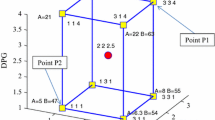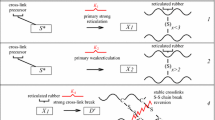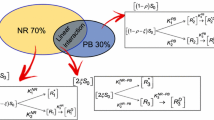Abstract
A closed form procedure to determine kinetic constants for NR vulcanized with sulphur is presented. The kinetic scheme originally proposed by Han et al. (Polymer (Korea) 22:223–230, 1998) and further modified by Milani et al. (Polym Test 32:1052–1063, 2013) is adopted as starting point to deduce a closed form expression for rubber curing degree. Rheometer experimental data collected at different temperatures are used to tune model parameters. After the normalization of the rheometer curves and the exclusion of induction period from calculations, the model requires the estimation of three kinetic constants, two of them describing incipient curing and stable crosslinks formations, the last reproducing reversion phenomenon. Whilst such constants are almost always determined by least-squares best fitting, here a numerical iterative procedure—much more stable and efficient from a computational standpoint—is proposed. The approach requires as input parameters only the degree of vulcanization at infinite (i.e. at the end of vulcanization), the instant where the maximum torque is reached and initial rate of vulcanization. The condition that the numerical curve reaches a maximum at a given time translates mathematically into a non-linear equation in two of the kinetic constants, which are determined iteratively in the paper. The numerical initial vulcanization rate is tuned in such a way to globally minimize the absolute error between numerical and experimental curves. The main capability of the procedure proposed stands in the very straightforward determination of reaction kinetic constants, avoiding demanding least-squares fittings on rheometer experimental data. A set of experimental data available, relying into rheometer curves of the same rubber blend conducted at five different temperatures are used to estimate the fitting capabilities of the mathematical model proposed. Very good agreement with experimental data is observed.








Similar content being viewed by others
References
I.S. Han, C.B. Chung, S.J. Kang, S.J. Kim, H.C. Chung, Polymer (Korea) 22, 223–230 (1998)
G. Milani, E. Leroy, F. Milani, R. Deterre, Polym. Test. 32, 1052–1063 (2013)
ASTM D2084–81 or ASTM D5289. ASTM Standard D5289. Oscillating disc and rotorless curometer tests Standard test method for vulcanization rubber and thermoplastic elastomers. Annual Book 2002
Y. Tanaka, Rubber Chem. Technol. 64, 325 (1991)
G. Wolfman, Hasenhidl, S. Wolf, Kautschuk Gummi Kunststoffe 44(2), 118 (1991)
A.Y. Coran, Science and Technology of Rubber (Academic Press, New York, 1978). Chapter 7
L. Pualing, The Nature of the Chemical Bond (Cornell University Press, Ithaca, 1959)
K.D.O. Jackson, M.J.R. Loadman, C.H. Jones, G. Ellis, Spectrochim. Acta 46(2A), 217 (1990)
G. Ellis, P.J. Hendra, M.J.R. Loadman, Kautschuk Gummi Kunststoffe 43(2), 118 (1990)
D.J.P. Harrison, W.R. Yates, J. Macromol. Sci. C 25, 481 (1985)
A.M. Zaper, J.L. Koenig, Rubber Chem. Technol. 60, 252 (1987)
R. Orza, P.C.M.M. Magusin, V.M. Litvinov, M. van Duin, M.A.J. Michels, Macromolecules 42, 8914–8924 (2009)
H.G. Dikland, M. van Duin, Crosslinking of EPDM and polydiene rubbers studied by optical spectroscopy, in Spectroscopy of Rubbers and Rubbery Materials, ed. by V.M. Litvinov, P.P. De (Rapra Technology Ltd., Shawbury, 2002), p. 207
T. Kemperman, Kautschuk Gummi Kunststoffe 40, 820 (1987)
E. Leroy, Souid, R. Deterre, Polym. Test. 32, 575–582 (2013)
G. Milani, F. Milani, J. Appl. Polym. Sci. 119, 419–437 (2011)
G. Milani, F. Milani, J. Math. Chem. 52(2), 464–488 (2014)
G. Milani, F. Milani, Polym. Test. 33, 1–15 (2014)
R. Ding, I. Leonov, J. Appl. Polym. Sci. 61, 455 (1996)
R. Ding, I. Leonov, A.Y. Coran, Rubber Chem. Technol. 69, 81 (1996)
M.R. Kamal, S. Sourour, Polym. Eng. Sci. 13, 59–64 (1973)
G. Milani, J. Math. Chem. 51, 465–497 (2013)
X. Colin, L. Audouin, J. Verdu, Polym. Degrad. Stab. 92(5), 906–914 (2007)
X. Sun, A.I. Isayev, Rubber Chem. Technol. 82(2), 149–169 (2009)
R.P. Quirk, Prog. Rubber Plast. Technol. 4(1), 31 (1988)
G. Milani, F. Milani, J. Appl. Polym. Sci. 115, 1995–2012 (2010)
G. Milani, F. Milani, Comput. Chem. Eng. 32, 3198–3212 (2008)
Author information
Authors and Affiliations
Corresponding author
Rights and permissions
About this article
Cite this article
Milani, G., Milani, F. Iterative robust numerical procedure for the determination of kinetic constants in Han’s model for NR cured with sulphur. J Math Chem 53, 1363–1379 (2015). https://doi.org/10.1007/s10910-015-0493-7
Received:
Accepted:
Published:
Issue Date:
DOI: https://doi.org/10.1007/s10910-015-0493-7




